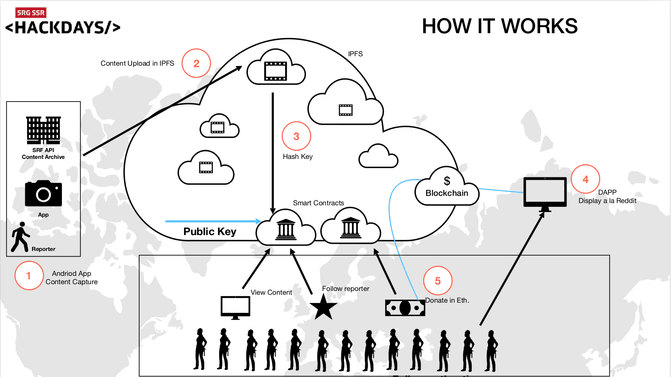It’s been a while since we’re interested in blockchain technology as we’ve always been watching closely the emergence of the latest frameworks that drive innovation.
Of course a few second-thoughts emerged here and there, considering the notorious ecological footprint of Bitcoin mining and also may be considering an instinctive defiance towards high-end finance systems that would blindly leverage Tech innovations for short-time personal profit.
As a reminder our key values are authenticity, accessibility and openness, so let’s put ourselves in openness-mode and have a close look into a recent Swiss blockchain project that was rewarded with the first price of the SRG /SSR Hackdaysin Zurich namely : “Blockchain Reporter” - originally conceived by Marko Nalis who teamed up with a few developers at the event and with whom he elaborated the project during the 13 hours the Hackathon took place.
“306” – in reference to the number of journalist imprisoned in Jan / Feb 2018 worldwide
Introducing his presentation with an intriguing image displaying the number “306”, Marko Nalis explained that this is the number of journalists imprisoned during the two first months of the year only. They are imprisoned in countries where free speech is not granted. Yes there are still a lot of those… ;-(
Starting from the recognition that journalists and reporters are exposed to persecution when personally identified (#1) and considering that they also suffer from a constant reduction of their financial means (#2) in a media landscape where advertising funds erode, the team came up with this cutting-edge blockchain concept : a decentralized peer-to-peer platform that enables journalists and readers to connect directly while injecting value into the ecosystem through tokenization & network effect.
There is more : through the magic touch of decentralized blockchain technology, other features are addressed too:
- anonymity of journalists,
- guarantee of safe payment,
- avoidance of censorship,
- authenticity of publications,
- prevention of fake news
- protection of the platform against arbitrary shut down by a totalitarian government (because decentralization prevents action against a unique IP server ;-).
Removal of the “middleman”
At this stage it’s already amazing to see how blockchain’s decentralization effect (i.e. removing the “middleman” – here the press agency –), simultaneously solves numerous parameters of the equation.
But let’s dive a little deeper into the functioning of the “token economy” (i.e. how publications and rewards are made possible by the community).
Nota Bene: this might become a little technical but we will try to guide you to illustrate the three elements, that are technically bound together to allow all parts to talk/interact.
Part 1 : ever heard of “Smart Contracts”?
Smart Contracts are independent, self-executing pieces of codes that are immutable, not controlled by anyone and can’t be manipulated – unless 51% on the users would own the blockchain – which is most unlikely on popular blockchains like Ethereum and Bitcoin.
Smart Contracts will fulfil some kind of “contract” a given condition is fulfilled once (it’s similar to the principle of IFTTT rules /“if this - then that” attribution rules, but more complex).
Mostly run on Ethereum which supports more opportunities than the Bitcoin blockchain (where you basically can transfer value only), these Smart Contracts don’t belong to somebody and will preserve the anonymity of journalists.
Part 2 : Linking the reference of the Smart Contract to a Public Address.
Let’s say a journalist filmed a given footage and wants to share it on the platform anonymously. Therefore he will use a dedicated android-based APP which allows uploading the content to a decentralized file-system called IPFS (=InterPlanetary File System).
IPFS uses a merkle tree architecture allowing the uploaded content to be split in chunks of data that are distributed on the network. The architecture ensures immutability and no single point of failure. (The blockchain itself not being efficient to store rich content, -due to transaction speed and cost-, it is used solely to publish a reference to the content in a specific Smart Contract).
Inside the Smart Contract the Public Address of a journalist is linked to his content and cryptographically signed. Thanks to the public address, the platform user will always be sure that the content of a given journalist is authentic - without even needing to know his real identity.
PART 3 : a “DAPP” / decentralized APP – linking the platform to Ethereum
Last the system needs a way to allow you “talking” to the Ethereum online wallet of the user/member.
A browser using HTML/ Javascript, adding Web 3 objects through a plug-in called Metamask. Web 3 enables you to make calls to the Ethereum network and call smart contract functions in Javascript. As these interactions with the blockchain will cost (as any open-source system Ethereum needs to be sustained) a small fee called “gas” charged to get the transactions through the network.
The system allows users to donate ether currency to journalists through the smart code. These donations are also used to rate the popularity of journalists : the more donations for a given article, the better is the rating.
Finally, a dedicated Ethereum framework called “Truffle” offers many tools to compile and deploy Smart Contracts and to set-up a test network. Its language is called “Solidity” and can be applied by any developer mastering Javascript, - in theory (although this quickly gets “a little complicated” as Marko Nalis says with a touch of understatement ;-)

In a nutshell – what’s in it for me?
So beyond the technical aspect of this analysis that will rather interest our Full Stack Developers, what innovation brings this “Blockchain Reporter” project?
Blockchain Reporter appears as a real-life use-case designing concrete and applicable value-transferring models in an interesting vertical (the press industry).
It was thrilling and uplifting to see how every parameter of the complex equation inherited its own place in the ecosystem organically (the donation/ranking logic, the token economy, the protection of the journalist). This is definitely a lesson for Liipers as this can help us design or deploy further models in other verticals.
It demonstrated that blockchain technology is not only meant for worldwide corporate companies, but it helps defend human values such a free speech and liberty.
We’re wishing long life and great success to the project “Blockchain Reporter”!

Here is the full LiipTalk from Marko Nalis : youtube.com/watch
For further interest about these topics of attribution and valutation of content in the medias, here is an interesting interview from a former journalist from Huffington Post who joined the startup Po.et aiming to create the first globally-verifiable record of digital media assets: https://bit.ly/2FEw2yh

